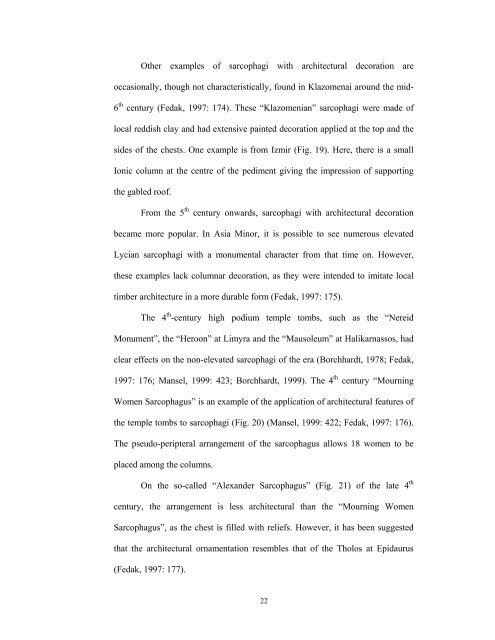To My Family and Uğraş Uzun - Bilkent University
To My Family and Uğraş Uzun - Bilkent University
To My Family and Uğraş Uzun - Bilkent University
You also want an ePaper? Increase the reach of your titles
YUMPU automatically turns print PDFs into web optimized ePapers that Google loves.
Other examples of sarcophagi with architectural decoration are<br />
occasionally, though not characteristically, found in Klazomenai around the mid-<br />
6 th century (Fedak, 1997: 174). These “Klazomenian” sarcophagi were made of<br />
local reddish clay <strong>and</strong> had extensive painted decoration applied at the top <strong>and</strong> the<br />
sides of the chests. One example is from Izmir (Fig. 19). Here, there is a small<br />
Ionic column at the centre of the pediment giving the impression of supporting<br />
the gabled roof.<br />
From the 5 th century onwards, sarcophagi with architectural decoration<br />
became more popular. In Asia Minor, it is possible to see numerous elevated<br />
Lycian sarcophagi with a monumental character from that time on. However,<br />
these examples lack columnar decoration, as they were intended to imitate local<br />
timber architecture in a more durable form (Fedak, 1997: 175).<br />
The 4 th -century high podium temple tombs, such as the “Nereid<br />
Monument”, the “Heroon” at Limyra <strong>and</strong> the “Mausoleum” at Halikarnassos, had<br />
clear effects on the non-elevated sarcophagi of the era (Borchhardt, 1978; Fedak,<br />
1997: 176; Mansel, 1999: 423; Borchhardt, 1999). The 4 th century “Mourning<br />
Women Sarcophagus” is an example of the application of architectural features of<br />
the temple tombs to sarcophagi (Fig. 20) (Mansel, 1999: 422; Fedak, 1997: 176).<br />
The pseudo-peripteral arrangement of the sarcophagus allows 18 women to be<br />
placed among the columns.<br />
On the so-called “Alex<strong>and</strong>er Sarcophagus” (Fig. 21) of the late 4 th<br />
century, the arrangement is less architectural than the “Mourning Women<br />
Sarcophagus”, as the chest is filled with reliefs. However, it has been suggested<br />
that the architectural ornamentation resembles that of the Tholos at Epidaurus<br />
(Fedak, 1997: 177).<br />
22
















